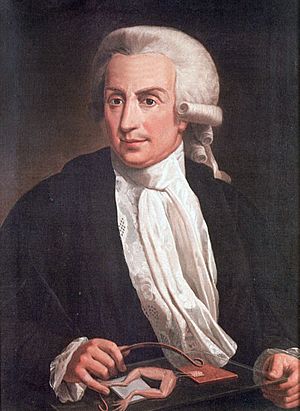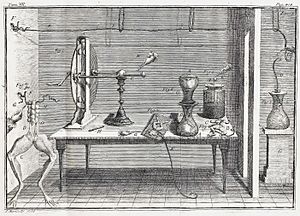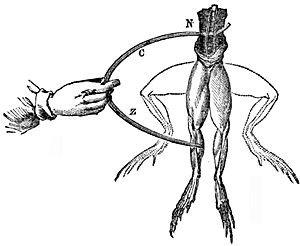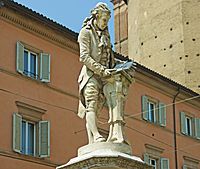Luigi Galvani facts for kids
Quick facts for kids
Luigi Galvani
|
|
|---|---|

Portrait of Galvani at the Palazzo Poggi
|
|
| Born | 9 September 1737 |
| Died | 4 December 1798 (aged 61) Bologna, Cisalpine Republic
|
| Known for | Bioelectricity (animal electricity) |
| Scientific career | |
| Institutions | University of Bologna |
Luigi Galvani (born September 9, 1737 – died December 4, 1798) was an Italian scientist. He was a doctor, a physicist, and a biologist. Galvani is famous for studying what he called "animal electricity."
In 1780, he made an amazing discovery. He found that the muscles in dead frogs' legs would twitch. This happened when they were touched by an electrical spark. This was one of the first studies of bioelectricity. Bioelectricity is the electricity made by living things. Other scientists like John Walsh and Hugh Williamson had also done similar experiments.
Contents
Early Life and Studies
Luigi Galvani was born in Bologna, Italy. At that time, Bologna was part of the Papal States. His father, Domenico Galvani, was a goldsmith.
Galvani became very interested in "medical electricity." This field became popular in the mid-1700s. Scientists were exploring how electricity affected the human body. Bertrand Bajon and Ramón M. Termeyer started these studies in the 1760s. Later, John Walsh and Hugh Williamson continued this work in the 1770s.
Galvani and Volta's Debate
Alessandro Volta was a physics professor at the University of Pavia. He was one of the first scientists to repeat Galvani's frog experiments. At first, Volta believed in "animal electricity."
However, Volta soon started to wonder. He doubted that the electricity came from the animal's body itself. Volta thought the muscle twitches happened because of the metal wires Galvani used. These wires connected the nerves and muscles.
Today, we know that every living cell has a small electrical charge. This biological electricity is similar to the current in batteries. It can even be created outside a living body. Volta's idea was actually correct!
Volta disagreed with Galvani's idea of a special "animal electric fluid." But they respected each other. Volta even created the term "Galvanism." This term described the direct electric current made by chemical reactions.
Galvani did not want to argue directly with Volta. So, he asked his nephew, Giovanni Aldini, to defend his theory.
Later Life and Death
Galvani kept studying animal electricity for the rest of his life. In 1797, a new government took over northern Italy. It was called the Cisalpine Republic. This government made all university professors promise loyalty to them.
Galvani did not agree with the new political changes. He refused to swear loyalty, just like some of his friends. Because of this, the new government took away all his jobs at the university. This also meant he lost all his money.
Luigi Galvani died peacefully on December 4, 1798. He was sad and poor, living in his brother's house. His mother and father were with him.
Galvani's Lasting Impact
Galvani's work had a huge impact on science and culture:
- His experiments were mentioned by Mary Shelley. She wrote the famous novel Frankenstein. In the story, Victor Frankenstein studies the ideas of galvanism. This helps him create his reanimated monster.
- Galvani's name is still used today. The verb 'galvanize' means to shock or excite someone into action.
- Many scientific terms also use his name. These include Galvani potential, galvanic cell, galvanic corrosion, galvanic current, and galvanometer.
William Fox said that Galvani was "courageous and religious." Another scientist, Jean-Louis-Marc Alibert, noted that Galvani always reminded his students about "eternal Providence." He believed this force creates and keeps life going.
Works
- De viribus electricitatis in motu musculari commentarius, 1791.
- Memorie sulla elettricità animale, 1797.
See also
 In Spanish: Luigi Galvani para niños
In Spanish: Luigi Galvani para niños





